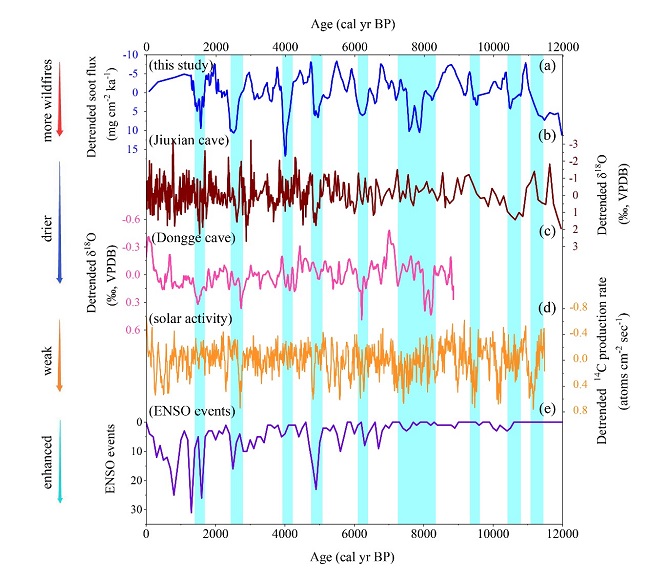The Linkage between Wildfire Activity and Abrupt Climate Events during the Holocene Revealed
As an important component of earth system, wildfire plays an important role in Earth's terrestrial ecosystems and climate system, with significant influences on the atmosphere, radiation effects, vegetation, surface properties, global biogeochemical cycles and human survival.Figuring out the interactions among wildfires, climate change, vegetation and human activities during geologic time is a practicable approach to help make accurate projection on wildfire occurrences in the future, which is crucial for human adoption to possible wildfire threat.
Recently, a research group led by Prof. HAN Yongming from the Institute of Earth Environment of the Chinese Academy of Sciences(CAS) reconstructed a high resolution wildfire history of monsoon marginal zone in Holocene by using soot record from Qinghai Lake sediments, to explore the relationship between wildfire and its possible driving factors.
They found that on sub-orbital timescale, less wildfire occurred during the early-middle Holocene under humid climate. With the weakened monsoon and enhanced aridification during the middle-late Holocene, wildfires increased and remained a high level since 3.0 BP. On a millennial timescale, there were extremely severe wildfire periods that were centered at ca. 1.6, 2.5, 4.1, 4.9, 6.3, 7.8, 9.6, 10.5 and 11.4 cal ka BP respectively, which were strongly correlated with millennial timescale abrupt weak monsoon events.
By comparing the soot records, climate proxies and possible driving factors, they also found that both on sub-orbital and millennial timescales, drought climate in association with a weakened monsoon, which was likely modulated by solar radiation (activity), might be the major factor driving the rapid increase of wildfires in the Holocene.
In general, temperature is considered to promote wildfire activity, with high temperature being favorable for wildfire occurrences. However, this work suggests that rapid wildfire increase is closely related to millennial timescale abrupt dry/cold climate events.
This work, published in Quaternary Science Reviews, may provide a new insight for fire prediction especially to those extreme wildfires as they frequently feedback to abrupt coal/dry climate events in monsoon-dominated regions.

Fig. 1 Comparison of extreme wildfire activity recorded from Qinghai Lake sediments with Holocene climatic events. a, Detrended soot flux from Qinghai Lake sediments (this study); b, stalagmite δ18O of Jiuxian cave (Cai et al., 2010); c, stalagmite δ18O of Dongge cave (Wang et al., 2005b); d, 14C production rate (Bond et al., 2001; Stuiver et al., 2016); e, Number of ENSO events per 100 yr (Moy et al., 2002). Green shaded bars mark rapid wildfire increases periods. (Image by HAO, et al)
Contact: Bai Jie, Institute of Earth Environment, Chinese Academy of Sciences, Xi'an, China. Email: baijie@ieecas.cn
 © 2015 Institute of Earth Environment,CAS
© 2015 Institute of Earth Environment,CAS Address:No. 97 Yanxiang Road, Xi'an 710061, Shaanxi, China

 Location :
Location :